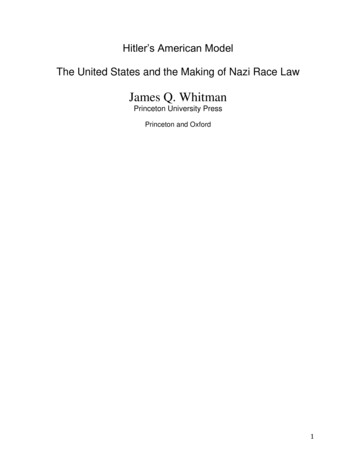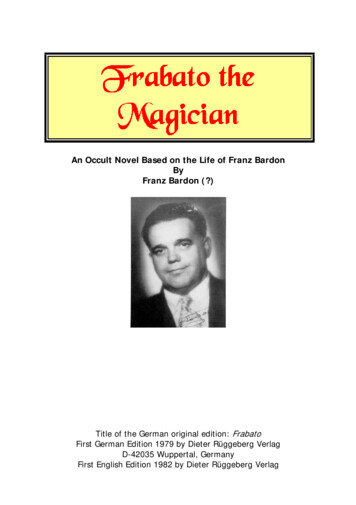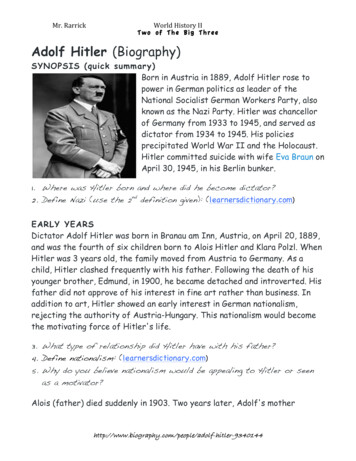
Transcription
Hitler’s American ModelThe United States and the Making of Nazi Race LawJames Q. WhitmanPrinceton University PressPrinceton and Oxford1
IntroductionThis jurisprudence would suit us perfectly, with a single exception. Over there they havein mind, practically speaking, only coloreds and half-coloreds, which includes mestizos andmulattoes; but the Jews, who are also of interest to us, are not reckoned among the coloreds.—Roland Freisler, June 5, 1934On June 5, 1934, about a year and a half after Adolf Hitler became Chancellor of the Reich, theleading lawyers of Nazi Germany gathered at a meeting to plan what would become theNuremberg Laws, the notorious anti-Jewish legislation of the Nazi race regime. The meeting waschaired by Franz Gürtner, the Reich Minister of Justice, and attended by officials who in thecoming years would play central roles in the persecution of Germany’s Jews. Among thosepresent was Bernhard Lösener, one of the principal draftsmen of the Nuremberg Laws; and theterrifying Roland Freisler, later President of the Nazi People’s Court and a man whose name hasendured as a byword for twentieth-century judicial savagery.The meeting was an important one, and a stenographer was present to record a verbatimtranscript, to be preserved by the ever-diligent Nazi bureaucracy as a record of a crucial momentin the creation of the new race regime. That transcript reveals the startling fact that is my point ofdeparture in this study: the meeting involved detailed and lengthy discussions of the law of theUnited States. In the opening minutes, Justice Minister Gürtner presented a memo on Americanrace law, which had been carefully prepared by the officials of the ministry for purposes of thegathering; and the participants returned repeatedly to the American models of racist legislation inthe course of their discussions. It is particularly startling to discover that the most radical Nazispresent were the most ardent champions of the lessons that American approaches held forGermany. Nor, as we shall see, is this transcript the only record of Nazi engagement with2
American race law. In the late 1920s and early 1930s many Nazis, including not least Hitlerhimself, took a serious interest in the racist legislation of the United States. Indeed in MeinKampf Hitler praised America as nothing less than “the one state” that had made progress towardthe creation of a healthy racist order of the kind the Nuremberg Laws were intended to establish.My purpose is to chronicle this neglected history of Nazi efforts to mine American racelaw for inspiration during the making of the Nuremberg Laws, and to ask what it tells us aboutNazi Germany, about the modern history of racism, and especially about America.* * *The Nazi persecution of the Jews and others, culminating in the Holocaust, counts for all of us asthe supremely horrible crime of the twentieth century, and the notion that Nazi policy makersmight have been in some way inspired by American models may seem a bit too awful tocontemplate. It may also seem implausible: we all think of America, whatever its undeniablefaults, as the home of liberty and democracy—as a country that put all of its might into the battleagainst fascism and Nazism that was finally won in 1945. Of course we also all know thatAmerica was home to its own racism in the era of the Nazi ascent to power, particularly in theJim Crow South. In the 1930s Nazi Germany and the American South had the look, in the wordsof two southern historians, of a “mirror image”:1 these were two unapologetically racist regimes,unmatched in their pitilessness. In the early 1930s the Jews of Germany were hounded, beaten,and sometimes murdered, by mobs and by the state alike. In the same years the blacks of theAmerican South were hounded, beaten, and sometimes murdered as well.2Nevertheless the idea that American law might have exerted any sort of direct influenceon the Nazi program of racial persecution and oppression is hard to digest. Whatever similaritiesthere may have been among the racist regimes of the 1930s, however foul the history of3
American racism may be, we are accustomed to thinking of Nazism as an ultimately unparalleledhorror. The crimes of the Nazis are the nefandum, the unspeakable descent into what we oftencall “radical evil.” No one wants to imagine that America provided any measure of inspirationfor Hitler. In any case, it may seem inherently improbable that Nazis would have felt the need tolook to any other country for lessons in racism—perhaps least of all to the United States, whichis, after all, whatever its failings, the home of a great constitutional tradition founded in liberty.And virtually no one has suggested otherwise, with the notable exception of a shrewdparagraph in Mark Mazower’s 2008 book Hitler’s Empire.3 Other scholars have insisted on whatmost of us must think of as the obvious truth: There was of course no direct American influenceon Nazi race law, or at least no meaningful influence. Whatever similarities there may have been,the Nazis were the authors of their own monstrous work; certainly America had nothing to teachHitler. The person who has given the question the most sustained attention is a German lawyernamed Andreas Rethmeier, who wrote a 1995 dissertation on the Nuremberg Laws that includedan examination of some of the many Nazi references to American law.4 After reviewing his dataRethmeier arrived at a disconcerting verdict: America was, for the Nazis, the “classic example”of a country with racist legislation.5 Nevertheless, he insisted forcefully that the idea ofAmerican influence on the Nuremberg Laws was “not just off-base, but plain wrong.” After all,he argued, the Americans classified Jews as “Caucasian,” a gross error from the Nazi point ofview.6Others have come to similar conclusions. “[T]he few and fleeting references by Nazipolemicists and ‘jurists’ to Jim Crow laws,” writes the American legal historian RichardBernstein, for example, “were, as far as I can tell, simply attempts to cite vaguely relevantprecedents for home-grown statutes and policies to deflect criticism, not actual sources of4
intellectual influence.”7 “[T]he segregation law of the states,” declares similarly Marcus Hankeof the University of Salzburg, “has not been of any important influence.”8 Most recently, JensUwe Guettel has written, in a 2012 book, of what he calls the “astonishing insignificance ofAmerican segregation laws” for Nazi policies. The Nazis, Guettel insists, regarded America ashopelessly mired in an outdated liberal outlook.9 There was nothing that deserves the name ofinfluence. All of these scholars are perfectly aware that the Nazis had things to say aboutAmerican law. But their reassuring consensus is that the Nazis said them merely in order toclaim a specious parallel to their racist programs in the face of international condemnation.10 TheNazis were interested in taunting America, not learning from it.The sources, read soberly, paint a different picture. Awful it may be to contemplate, butthe reality is that the Nazis took a sustained, significant, and sometimes even eager interest in theAmerican example in race law. They most certainly were interested in learning from America. Infact, as we shall see, it was the most radical Nazis who pushed most energetically for theexploitation of American models. Nazi references to American law were neither few nor fleeting,and Nazi discussions took place in policy-making contexts that had nothing to do with producinginternational propaganda on behalf of the regime. Nor, importantly, was it only, or evenprimarily, the Jim Crow South that attracted Nazi lawyers. In the early 1930s the Nazis drew ona range of American examples, both federal and state. Their America was not just the South; itwas a racist America writ much larger. Moreover, the ironic truth is that when Nazis rejected theAmerican example, it was sometimes because they thought that American practices were overlyharsh: for Nazis of the early 1930s, even radical ones, American race law sometimes looked tooracist.Be it emphasized immediately that there was certainly never anything remotely like5
unmixed admiration for America among the Nazis, who aggressively rejected the liberal anddemocratic commitments of American government. The Nazis were never interested in simplyreplicating the United States in Central Europe. Nevertheless Nazi lawyers regarded America,not without reason, as the innovative world leader in the creation of racist law; and while theysaw much to deplore, they also saw much to emulate. It is even possible, indeed likely, that theNuremberg Laws themselves reflect direct American influence.* * *The proposition that the Nazis drew inspiration from American race law in creating their ownprogram of racist persecution is sure to seem distressing; no one wants the taint of an associationwith the crimes of Nazism. But in the end it should really come as no great surprise to attentivereaders of Nazi history. In recent years historians have published considerable evidence of Naziinterest in, and even admiration for, a range of American practices, programs, and achievements.Especially in the early years of the regime, the Nazis did not by any means regard the UnitedStates as a clear ideological enemy.In part, the Nazis looked to America for the same more or less innocent reasons othersdid all around the globe. The United States is powerful, wealthy, and creative, and even its mostvisceral enemies have found things to admire about it. During the century or so since 1918 theglamour of America has proven particularly hard to resist. As interwar German racists observed,the United States had emerged after World War I as “the premier power in the world”;11 it ishardly a surprise that the Nazis, like others, looked for what lessons the global powerhouse mighthave to teach, even as they also derided the liberal and democratic commitments of Americansociety. Like others, the Nazis were impressed by the vigor of American industrialinnovativeness and the vibrancy of Hollywood culture (though their taste for American culture6
was heavily qualified by their disgust for the “Negro music” of Jazz).12 Hitler in particularvoiced his admiration, in Mein Kampf, for the “wealth of inventions” generated by the UnitedStates.13 None of this was peculiar to Nazi Germany.14But historians have shown that there were also things about America that appealed tomore distinctively Nazi views and goals. Some of this involved the American politics of the early1930s. We have long known the strange fact that the Nazis frequently praised Franklin Rooseveltand New Deal government in the early 1930s. FDR received distinctly favorable treatment in theNazi press until at least 1936 or 1937, lauded as a man who had seized “dictatorial powers” andembarked upon “bold experiments” in the spirit of the Führer.15 Similar things were said morebroadly about what was sometimes labeled in the 1930s “the fascist New Deal.”16 The glossyBerlin Illustrated Magazine, seized from its Jewish publisher and converted into a kind of NaziLife magazine, ran heroic photo spreads on Roosevelt;17 while Nazi rags like Will and Power, thenewsletter of the Hitler Youth, described him as a “revolutionary” who might fail only becausehe lacked “a disciplined Party army like our Führer.”18 Meanwhile Roosevelt, for his part,though he was certainly troubled by the persecution of the German Jews and had harsh words for“dictators,” cautiously refrained from singling out Hitler until 1937 or even 1939.19 There werecertainly not deep ties of friendship between the two governments in the early 1930s, but the pallof unconditional hostility had not yet clearly fallen over US/German relations either. In thisconnection it is worth emphasizing, as the political scientist Ira Katznelson has recently done,that the New Deal depended heavily on the political support of the segregationist South.20 Therelationship between the northern and southern Democrats was particularly cozy during the early1930s, a period when, as we shall see, Nazi observers were particularly hopeful that they could“reach out the hand of friendship” to the United States on the basis of a shared commitment to7
white supremacy.21To be sure, there are ways of minimizing the significance of the favorable press given toNew Deal America in Nazi Germany. Nobody would suggest that Hitler was inspired by theexample of FDR to become a dictator; and in any casethe reality is that the American presidentwas a committed democrat, who preserved American constitutional government at a time whenit was under ominous stress.22 If the United States and Germany, both confronting the immensechallenges of the Great Depression, found themselves resorting to similar “bold experiments,”that does not make them intimate bedfellows.23 And whatever the Nazis may have thought aboutsouthern racism, southern whites themselves did not generally become supporters of Hitler.24 Ifthe Nazis regarded New Deal America as a potential comrade in arms, that does not necessarilytell us much about what kind of a country America really was.But—and here recent scholarship on German-American relations becomes moretroubling—historians have also tracked down American influence on some of the mostunambiguously criminal Nazi programs—in particular on Nazi eugenics and the murderous Naziconquests in Eastern Europe.Begin with eugenics. A ruthless program of eugenics, designed to build a “healthy”society, free of hereditary defects, was central to Nazi ambitions in the 1930s. Soon after takingpower, the regime passed a Law to Prevent the Birth of the Offspring with Hereditary Defects,and by the end of the decade a program of systematic euthanasia that prefigured the Holocaust,including the use of gassing, was under way.25 We now know that in the background of thishorror lay a sustained engagement with America’s eugenics movement. In his 1994 book TheNazi Connection: Eugenics, American Racism, and German National Socialism, historian StefanKühl created a sensation by demonstrating that there was an active back-and-forth traffic8
between American and Nazi eugenicists until the late 1930s, indeed that Nazis even looked to theUnited States as a “model.”26 During the interwar period the United States was not just a globalleader in assembly-line manufacturing and Hollywood popular culture. It was also a globalleader in “scientific” eugenics, led by figures like the historian Lothrop Stoddard and the lawyerMadison Grant, author of the 1916 racist best-seller The Passing of the Great Race; or, TheRacial Basis of European History. These were men who promoted the sterilization of thementally defective and the exclusion of immigrants who were supposedly genetically inferior.Their teachings filtered into immigration law not only in the United States but also in otherAnglophone countries: Britain, Australia, Canada, and New Zealand all began to screenimmigrants for their hereditary fitness.27 Kühl demonstrated that the impact of Americaneugenics was also strongly felt in Nazi Germany, where the works of Grant, Stoddard, and otherAmerican eugenicists were standard citations.To be sure, there are, here again, ways we may try to minimize the significance of theeugenics story. American eugenicists, repellant though they were, did not advocate masseuthanasia, and the period when the Nazis moved in their most radically murderous direction, atthe very end of the 1930s, was also the period when their direct links with American eugenicsfrayed. In any case, eugenics, which was widely regarded as quite respectable at the time, was aninternational movement, whose reach extended beyond the borders of both the United States andNazi Germany. The global history of eugenics cannot be told as an exclusivelyGerman/American tale. But the story of Nazi interest in the American example does not end withthe eugenics of the early 1930s; historians have carried it into the nightmare years of theHolocaust in the early 1940s as well.It is here that some of the most unsettling evidence has been assembled, as historians9
have shown that Nazi expansion eastward was accompanied by invocations of the Americanconquest of the West, with its accompanying wars on native Americans. This tale, by contrastwith the tale of eugenics, is a much more exclusively German/American one. The Nazis wereconsumed by the felt imperative to acquire Lebensraum, “living space,” for an expandingGermany that would engulf the territories to its east, and “[f]or generations of Germanimperialists, and for Hitler himself, the exemplary land empire was the United States ofAmerica.”28 In Nazi eyes, the United States ranked alongside the British, “to be respected asracial kindred and builders of a great empire”:29 both were “Nordic” polities that had undertakenepic programs of conquest.Indeed as early as 1928, Hitler was speechifying admiringly about the way Americanshad “gunned down the millions of Redskins to a few hundred thousand, and now keep themodest remnant under observation in a cage”;30 and during the years of genocide in the early1940s Nazi leaders made repeated reference to the American conquest of the West whenspeaking of their own murderous conquests to their east.31 Historians have compiled manyquotes, from Hitler and others, comparing Germany’s conquests, and its program ofextermination, with America’s winning of the West. They are quotes that make for chillingreading, and there are historians who try to deny their significance.32 But the majority of scholarsfind the evidence too weighty to reject: “The United States policy of westward expansion,” asNorman Rich forcefully concludes, for example, “in the course of which the white menruthlessly thrust aside the ‘inferior’ indigenous populations, served as the model for Hitler’sentire conception of Lebensraum.”33All of this adds up to a tale of considerable Nazi interest in what the example of theUnited States had to offer. It is a tale that has to be told cautiously. It is surely too much to call10
the United States “the” model for Nazi Germany without careful qualification; Nazi attitudestoward America were too ambivalent, and Nazi programs had too many indigenous sources.America, for its part, as we shall see, embodied too much of what the Nazis hated most, at leastin its better moments. If the Nazis found precedents and parallels and inspirations in America,they nevertheless struck out on their own path. Still, what all this research unmistakably revealsis that the Nazis did find precedents and parallels and inspirations in the United States.* * *It is against that background that I ask the reader to ponder the evidence that this book has topresent. In the early 1930s, as the Nazis were crafting the program of racial persecutionenshrined in the Nuremberg Laws, they took a great interest not only in the way Henry Ford builtcars for the masses, not only in the way Hollywood built its own mass market, not only in FDR’sstyle of government, not only in American eugenics, and not only in American westwardexpansion, but also in the lessons to be garnered from the techniques of American racistlegislation and jurisprudence.Scholars have failed to write this history for two reasons: they have been looking in thewrong place and have been employing the wrong interpretive tools. First and foremost, they havebeen looking in the wrong place. Scholars like Guettel and Hanke have addressed their questionin unmistakably American terms. What Americans ask is whether “Jim Crow” had any influenceon the Nazis; and by “Jim Crow” they mean segregation as it was practiced in the AmericanSouth and fought over in the American civil rights era from the early 1950s into the mid-1960s—segregation in education, public transportation, housing, and the like. Looking for an influence ofAmerican segregation law on the Nazis, Guettel and Hanke conclude that there was little ornone. Now, as we shall see, that conclusion is too hasty. The Nazis did know, and did care, about11
American segregation; and it is clear that some of them were intrigued by the possibility ofbringing Jim Crow to Germany. As we shall see, important programmatic Nazi texts made apoint of invoking the example of Jim Crow segregation, and there were leading Nazi lawyerswho made serious proposals that something similar ought to be introduced into Germany.34 Butthe principal difficulty with the conclusions of Guettel and Hanke is that they are answering thewrong question. Segregation is not what counts most.Yes it is true that segregation in the style of the American South did not matter all thatmuch to the Nazi regime—but that is for the simple reason that segregation was not all thatcentral to the Nazi program. The Nuremberg Laws said nothing about segregation. Theirconcern, and the overwhelming concern of the Nazi regime of the early 1930s, lay in two otherdomains: first, citizenship, and second, sex and reproduction. The Nazis were committed to theproposition that “every State has the right to maintain its population pure and unmixed,”35 safefrom racial pollution. To that end they were determined to establish a citizenship regime thatwould be firmly founded on racial categories. They were further determined to prevent mixedmarriages between Jews and “Aryans,” and to criminalize extramarital sex between members ofthe two communities.36In both respects they found, and welcomed, precedent and authority in American law, andby no means just in the law of the South. In the 1930s the United States, as the Nazis frequentlynoted, stood at the forefront of race-based lawmaking. American immigration and naturalizationlaw, in the shape of a series of laws culminating in the Immigration Act of 1924, conditionedentry into the United States on race-based tables of “national origins.” It was America’s racebased immigration law that Hitler praised in Mein Kampf, in a passage that has been oddlyneglected by American legal scholars; and leading Nazi legal thinkers did the same after him,12
repeatedly and volubly. The United States also stood at the forefront in the creation of forms ofde jure and de facto second-class citizenship for bs, Filipinos, Chinese, and others; this too wasof great interest to the Nazis, engaged as they were in creating their own forms of second-classcitizenship for Germany’s Jews. As for race mixing between the sexes, the United States stood atthe forefront there as well. America was a beacon of anti-miscegenation law, with thirty differentstate regimes—many of them outside the South, and all of them (as we shall see) carefullystudied, catalogued, and debated by Nazi lawyers. There were no other models for miscegenationlegislation that the Nazis could find in the world, a fact that Justice Minister Gürtner highlightedat the June 5, 1934, meeting with which I began. When it came to immigration, second-classcitizenship, and miscegenation, America was indeed “the classic example” of a country withhighly developed, and harsh, race law in the early 1930s, and Nazi lawyers made repeatedreference to American models and precedents in the drafting process that led up to theNuremberg Laws and continued in their subsequent interpretation and application. The tale is byno means one of “astonishing insignificance.”The scholars who dismiss the possibility of American influence on Nazi lawmaking havealso used the wrong interpretive tools in making their case. Our literature has taken a crassinterpretive tack: it has assumed that we can speak of “influence” only where we find direct andunmodified, even verbatim, imitation. That is the assumption behind Rethmeier’s confidentassertion that American race law could not have influenced the Nazis, since American law didnot specifically target Jews. We find the same assumption in Hanke: Nazi law was simplydifferent, Hanke declares, because the German laws of the early 1930s were “but one step on thestair to the gas chambers.”37 Unlike American segregation laws, which simply applied theprinciple of “separate but equal,” German laws were part of a program of extermination. Now13
part of the problem with this argument, which Hanke is by no means alone in offering,38 is thatits historical premise is false: It is simply not the case that the drafters of the Nuremberg lawswere already aiming at the annihilation of the Jews in 1935. The concern of early Nazi policywas to drive the Jewish population into exile, or at the very least to marginalize it within theborders of the Reich, and there were serious conflicts among Nazi policy makers about how toachieve even that goal.But in any case, it is a major interpretive fallacy on the part of all these scholars tosuppose that we cannot speak of “influence” unless Nazi laws were perfectly congruent withAmerican ones. As we shall see, Nazi lawyers had no difficulty exploiting American law on race,even if it had nothing to say about Jews as such. In any case, influence in comparative law israrely just about literal imitation. Influence is a complex business of translation, creativeadaptation, selective borrowing, and invocation of authority. All borrowers engage in tinkeringand retrofitting; that is as true of the Nazis as it is of any other regime. All borrowers start fromforeign models and then reshape them to meet their own circumstances; that is true of viciousracist borrowers just as it is true of everyone else.Influence does not come just through verbatim borrowing. It comes through inspirationand example, and the United States had much inspiration and example to offer Nazi lawyers inthe early 1930s, the era of the making of the Nuremberg Laws.* * *None of this is entirely easy to talk about. There is more than one reason why it is hard to lookcoolly on the question of whether the racist program of the Nazis was influenced by, or evenparalleled by, what went on in other Western regimes—just as it is hard to admit the continuitiesbetween Nazism and the postwar European orders that replaced it. No one wants to be perceived14
as relativizing Nazi crimes. Germans in particular are generally understandably reluctant toengage in discussions that might smack of apologetics. Contemporary Germany rests on themoral foundation not only of the repudiation of Nazism, but also of the refusal to deny Germanresponsibility for what happened under Hitler. Alluding to foreign influences remains largely outof bounds in Germany for that reason. Conversely no non-Germans want their country to beaccused of any part in the genesis of Nazism. It is hard to overcome our sense that if weinfluenced Nazism we have polluted ourselves in ways that can never be cleansed. On thedeepest level it is perhaps the case that we feel, throughout the Western world, a need to identifya true nefandum, an abyss of unexampled modern horror against which we can define ourselves,a wholly sui generis “radical evil”—a sort of dark star to steer by lest we lose our moralbearings.But of course history does not make it that easy. Nazism was not simply a nightmarishparenthesis in history that bore no relationship to what came before and after; nor was it acompletely unexampled racist horror. The Nazis were not simply demons who erupted out ofsome dark underworld to shatter what was good and just within the Western tradition, until theywere put down by force of arms and the authentic humane and progressive values of Europewere restored. There were traditions of Western government within which they worked. Therewere continuities between Nazism and what came before and after. There were examples andinspirations on which the Nazis drew, and American race law was prominent among them.None of this is to suggest that America was a Nazi country in the 1930s. Of course it wasnot, appalling as the law of the early and mid-twentieth century sometimes was. Of course theracist strains in American law coexisted and competed with some glorious humane andegalitarian strains. Of course thoughtful Americans reviled Nazism—though there were certainly15
some who fell for Hitler. The most famous of the lawyers among them was none other thanRoscoe Pound, dean of the Harvard Law School, icon of advanced American legal thought, and aman who made little secret of his liking for Hitler in the 1930s.39 Nazi lawyers for their part sawplenty of things to despise about America.The point is not that the American and Nazi race regimes were the same, but that theNazis found examples and precedents in the American legal race order that they valued highly,while simultaneously deploring, and puzzling over, the strength of the liberal countercurrent in acountry with so much openly and unapologetically sanctioned racism. We can, and should, rejectthe sort of simple-minded anti-Americanism that blames the United States for all the evils of theworld, or reduces America to nothing but its history of racism.40 But there is no excuse forrefusing to confront hard questions about our history, and about the history of Americaninfluence abroad. The American impact on the rest of the world is not limited to what makesAmericans proudest about their country. It has also included aspects of the American past thatwe might prefer to forget.We will not understand the history of National Socialist Germany, and more importantlythe place of America in the larger history of world racism, unless we reckon with these facts. Inthe early 1930s, Nazi lawyers were engaged in creating a race law founded on antimiscegenation law and race-based immigration, naturalization, and second-class citizenship law.They went looking for foreign models, and found them—in the United States of America.***16
Chapter 2Protecting Nazi Blood and NaziHonorDr. Möbius: I am reminded of something an American said to us recently. Heexplained, “We do the same thing you are doing. But why do you have to say it soexplicitl
Jim Crow South. In the 1930s Nazi Germany and the American South had the look, in the words of two southern historians, of a “mirror image”:1 these were two unapologetically racist regimes, unmatched in their pitilessness. In the early 1930s the Jews of Germany were hounded, beaten










